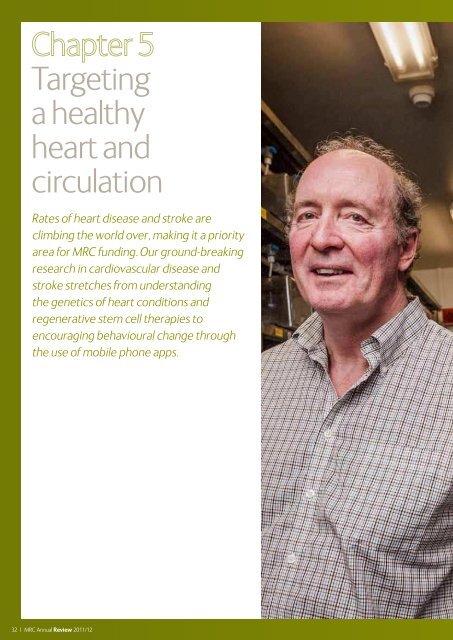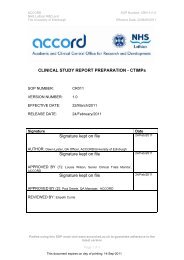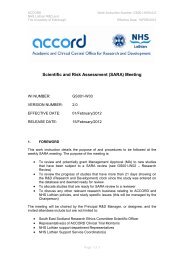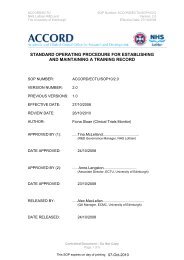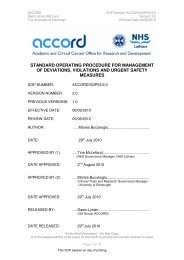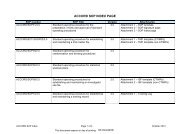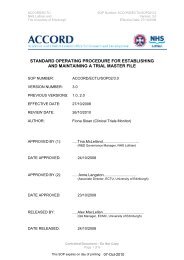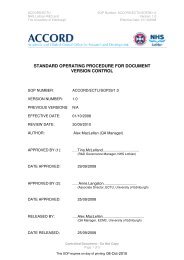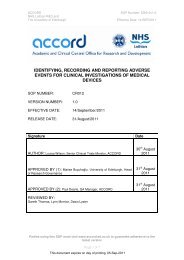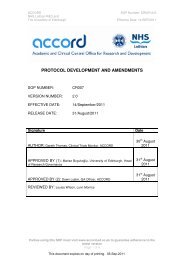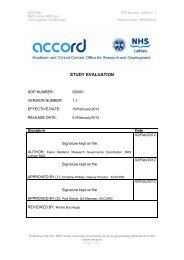Advancing medicine, changing lives - Medical Research Council
Advancing medicine, changing lives - Medical Research Council
Advancing medicine, changing lives - Medical Research Council
You also want an ePaper? Increase the reach of your titles
YUMPU automatically turns print PDFs into web optimized ePapers that Google loves.
PROFILE: Professor Roger Patient, MRC Molecular Haematology Unit, Oxford<br />
Targeting<br />
a healthy<br />
heart and<br />
circulation<br />
Rates of heart disease and stroke are<br />
climbing the world over, making it a priority<br />
area for MRC funding. Our ground-breaking<br />
research in cardiovascular disease and<br />
stroke stretches from understanding<br />
the genetics of heart conditions and<br />
regenerative stem cell therapies to<br />
encouraging behavioural change through<br />
the use of mobile phone apps.<br />
Every six minutes someone dies of a heart attack in the UK.<br />
Heart attack is a frightening and debilitating condition that<br />
can cause permanent damage to the heart in those who<br />
survive it, drastically altering the patient’s health. But what if<br />
there was a way to repair the heart and allow these patients<br />
to lead a normal life again?<br />
That is one of the many quests of Professor Roger Patient<br />
at the MRC Molecular Haematology Unit (MHU) in Oxford,<br />
who is investigating the possibility of using stem cell<br />
therapy to regenerate damaged heart muscle.<br />
Roger started his scientific career as a chemist, but soon<br />
decided that DNA was by far the most interesting chemical<br />
he’d studied and made the leap to genetics. At that time,<br />
the first experiments to transfer animal genes into bacterial<br />
cells were taking place, and Roger recalls being accosted by<br />
news reporters on his way into work who wanted to know if<br />
he was making a ‘test tube monster’.<br />
Later he shifted gear again into developmental genetics<br />
after making the seminal discovery that embryonic and<br />
adult red blood cells are descended from entirely different<br />
cell lineages. It’s in this field that he’s worked for the past 20<br />
years, researching how the blood and cardiovascular system<br />
forms in the developing embryo.<br />
But these days, as a senior scientist at the MHU, Roger is<br />
more likely to be found grappling with research problems<br />
than pipettes.<br />
“I became a lab head because for me, the exciting thing<br />
about research is the concepts and ideas. Although I loved<br />
doing the experiments, I consciously dropped being handson<br />
to make the lab bigger and to broaden the reach of what<br />
we were able to do,” explains Roger.<br />
And his lab’s remit is certainly broad. Unravelling the<br />
intricacies of how cells, genes and molecules come<br />
together in the embryo to make blood, veins and heart can<br />
teach us about congenital heart defects, blood cancers and<br />
even how to repair damage inflicted by a heart attack.<br />
In 2011, Roger’s group published research they’d carried<br />
out in zebrafish – a creature with an incredible ability to<br />
regenerate its heart muscle, even as an adult.<br />
But what’s the relevance for human health?<br />
“Our bodies are able to regenerate tissues like liver and<br />
skeletal muscle when they are damaged, but we can’t<br />
regenerate cardiac muscle. So if this muscle is damaged<br />
through heart attack, where there’s a blocked artery, we<br />
never get the use of it back. Further heart attacks will lead<br />
to heart failure because there’s no healthy muscle left,”<br />
Roger explains.<br />
“So if we can we can manipulate these heart stem cells in<br />
fish embryos to make new tissue, in the longer term we can<br />
look to try and do the same in human hearts – even adult<br />
hearts – if we can identify the equivalent cells in people.”<br />
Repairing the heart would not only require regeneration of<br />
the muscle but also the vessels that supply it with blood.<br />
So if the same population of cells exist in human beings as<br />
Roger’s group has found in zebrafish, it might be possible<br />
to manipulate them to regenerate both types of tissue,<br />
perhaps by giving drugs which mimic the signals that tell<br />
cells to turn into one type or the other.<br />
The research also gives fascinating insights into how our<br />
large, four-chambered hearts have evolved over millions<br />
of years from the simple, two-chambered fish heart. Roger<br />
and his team think the population of cells they’ve found<br />
in zebrafish were diverted as we evolved in order to make<br />
more heart muscle to increase the organ’s size.<br />
“Our hope is that, in humans, if these cells were recruited<br />
into the muscle-making population of cells in recent<br />
evolutionary history they may have retained a ‘memory’ of<br />
making the cells of veins and arteries,” explains Roger.<br />
Regenerative <strong>medicine</strong> brings to mind science fiction images<br />
of pulsating hearts growing in Petri dishes, but Roger thinks<br />
the answer will lie in stimulating the body to repair itself<br />
from within rather than transplanting tissue grown in the lab.<br />
“If you transplant tissue into a heart, the cells have got<br />
to organise themselves. And with a three-dimensional<br />
structure like a heart that’s going to be very difficult. So<br />
my thought is that they will be more likely to organise<br />
themselves if they’re growing in situ than if they are<br />
dropped in from the outside.”<br />
The research showed that a protein called Fibroblast growth<br />
factor (Fgf) can influence whether developing heart stem<br />
cells become either new heart muscle or new blood vessels.<br />
By manipulating levels of the Fgf protein in zebrafish<br />
embryos and causing it to switch various genes on and off,<br />
Roger’s group was able to control how many of each cell<br />
type was made.<br />
It’s early days for this research, and for now the search<br />
continues for this elusive population of cells in people. But<br />
Roger’s still hopeful that we might have an idea of how to<br />
regenerate human heart tissue within five to ten years.<br />
“It used to be that people like me working on basic research<br />
would feel a long way from research going to the clinic, but<br />
nowadays we don’t feel so far away,” he says.<br />
32 | MRC Annual Review 2011/12 MRC Annual Review 2011/12 | 33


